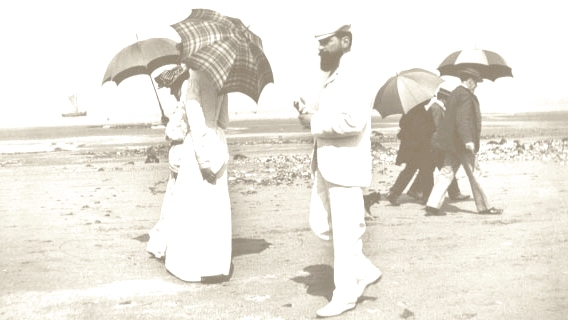Inventory at Dusk
...So at first I was not needed.
I knelt under the sky blue sky
of the lips, and traced the final motion
where the hand had curled
like a fern...
[...]
...I sang for his wild mouth.
I sang instead of truth.
I sang for a place to lean on....
Robin Behn
Poetry Daily
25.Feb.05
26.2.05
25.2.05
I grew up inside that building. It was my home in my home town. I can't call it a house though, because it isn't a house, the garages underneath are for other dwellings, for other dwellers' use. So it's not independent like a house, not self-contained. Yet it's not an apartment, because it's by itself, there aren't any other apartments with it. It sits in the middle of a block, down a driveway past what was when I lived there the landlord's house, looking down on the neighbors' yards, their backyards, what are usually, in small towns, private spaces. You could see the park out the kitchen window, to the east. There were big trees in back that filled the windows and there was the driveway in front so you could see a car coming home. At the top of the stairs, which were steep, was the kitchen door, straight ahead. To the right at the landing at the top of the stairs was a window that also looked out on the park, like the kitchen window did. To the left was the living room door, the front door. The kitchen door had a sliding window in it and a screen on that. There was only a king-post between the two doors.
So, on the landing there were four perspectives, one behind you and one in front and two at either side, four differing lines, and the front door and the kitchen door were right next to each other, at right angles. And that was my home.
still here 12:25
23.2.05
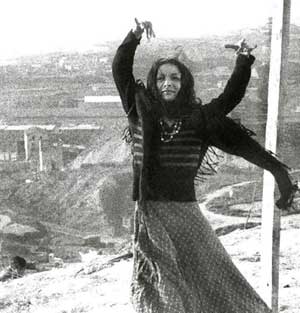
She was born in a thatched hut in Somorrostro. Her father was Francisco Amaya, "el Chino", a guitarist who made a harsh living "from one tavern to another, in permanent late nights of sour wine and thick vomit". When she was no more than four years old and was a skinny dark Gypsy girl, Carmen began to go out with her father at night to earn a living. The man played the guitar and the girl sang and danced. Then they passed the hat round, or simply picked up the coins the public threw on the ground.
“And the woman...that humanity she had that made her special. My family lived in Somorrostro, where Carmen was born, so they were neighbors.
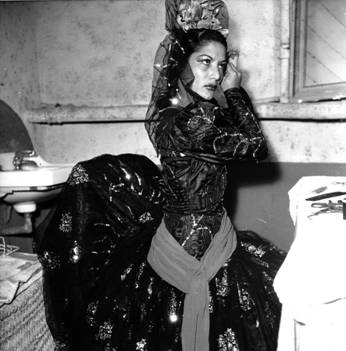 My older sister tells how she performed in the theater in Barcelona...all the tickets were sold out and many gypsies from Somorrostro couldn’t get in, either because they couldn’t afford it or because there were no tickets left. When Carmen found out, she went right to the neighborhood and danced for her ‘gitanicos’”.
My older sister tells how she performed in the theater in Barcelona...all the tickets were sold out and many gypsies from Somorrostro couldn’t get in, either because they couldn’t afford it or because there were no tickets left. When Carmen found out, she went right to the neighborhood and danced for her ‘gitanicos’”.Dolores Giménez
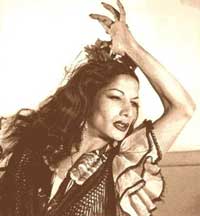
Flamenco today is deeply indebted to Carmen Amaya.Through her artistry and virtuosity, she effectively altered the history of flamenco dance forever.
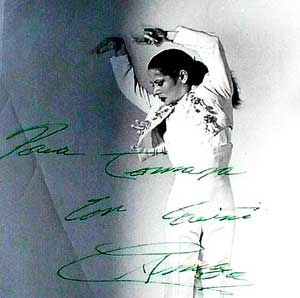
She crossed the traditional boundaries of flamenco by teaching herself the fast and furious footwork usually reserved for the male dancer. Donning a man's pants and jacket, she skillfully combined the elegance and grace of the female style with the ferocity and high-impact footwork of the male style sending shockwaves through the flamenco world unaccustomed to seeing a passionate and powerful woman in pants dancing a man's dance.
On his meeting with Carmen Amaya, Sabicas said, "We met when we were both children in Barcelona. I went to work there and I saw her dance one day – she was very young too. I became friends with her and her family." "I met Carmen in a restaurant called Casa de Manquet. There on the dock, where all the sailors used to go. A singer took me there, telling me, ‘Come, you’ll see someone dance’ I went in. The flamenco atmosphere was great. There was Carmen, very young. I was stunned to see what she could do... her hands, her feet... She carried everyone." "I saw her dance and it seemed like something supernatural to me... I never saw anyone dance like her. I don’t know how she did it, I just don’t know!".


Kazuo Ohno was born in 1906 in Hokkaido, Japan.
In 1926 Ohno made his way to Tokyo where he enrolled in the National School of Athletics. Shortly afterwards he encountered a performance of the Spanish dancer La Argentina, and began to dance. La Argentina inspired something in Ohno that never left him and became the impetus of his most famous performance Admiring La Argentina. Of La Argentina Kazuo said, "The dance of La Argentina invited people into a sea of excitement. She embodied dance, literature, music and art and furthermore she represented love and pain in real life."
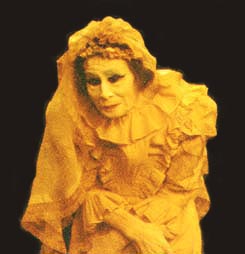
How to explain the dance performance of a 90 year old man? To merely describe the movement style or the choreography does not really bring forth the grace and dignity of his presence. Kazuo Ohno "performs" with the expression on his face, each small gesture and even in his stillness.
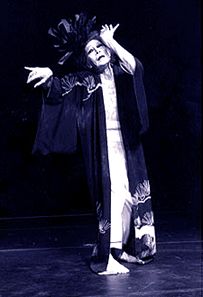 His form of Butoh dance is one in which structure is not most important. Instead, he is interested in bringing to life a quality of being embued with energy and emotion. His movement is not technically skilled but filled with an almost mystical sincerity.
His form of Butoh dance is one in which structure is not most important. Instead, he is interested in bringing to life a quality of being embued with energy and emotion. His movement is not technically skilled but filled with an almost mystical sincerity.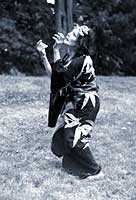
The curtain call is also a great part of this performance experience. Ohno comes down stage to communicate his thanks for the applause. He remains on-stage, laying on the floor, bowing, kneeling, ready to wait with us until we decide to end the applause. This has just the opposite affect, causing a standing ovation, which in turn causes Ohno to leap across the stage, smiling and making idiosyncratic, often humorous, gestures. All of this is sincere and spontaneous. There is nothing rigid about his place on stage and our place in the audience.
During the five years of performance before he and Hijikata met, Ohno's work was notably inspired by the evocations of the spirit. Said Kazuo Ohno of his greatest inspiration, "I had read about the creation of the world in the Bible; I'd always accepted it as a legend, but in La Argentina's work I saw it realized in front of my eyes. If this is creation, I would like to lift one corner of it."

still here 15:15
21.2.05

Portrait of Mary Ellen Meredith
Henry Wallis
-
"Henry Wallis's deeply sensitive portrait of his lover, the beautiful Mary Ellen Meredith (1821-61) dates the same year that she gave birth to their son Harold, known as Felix, who was born in April 1858.link Art "4" "2" -Day 21.Feb.05
[...]
Mary Ellen was an adept writer, she was witty, intellectual and free-spirited. Holman-Hunt described her as a "dashing horsewoman", while C. L. Clodd's Memoirs recalled that those "who knew her say she was charming, with intellectual gifts above average". She was a woman who broke all Victorian conventions when in the summer of 1857 she left her husband. Contrary to popular belief she did not elope with Wallis immediately although their affair had probably begun in about February that year. Rather the independently minded Mrs Meredith went with her two small children to Seaford, intending to live by her own writing and on a small private income. During the late summer she and Wallis spent a glorious holiday in Wales and the following April their son Harold was born. She was the eldest of five children, born in Stamford Street London in July 1821. Following the death of her sister in 1826 her mother suffered increasing mental illness so Mary Ellen was largely raised by her adoring father, who taught her to pursue life and knowledge to the full.
Thomas Love Peacock, a child of the enlightenment, was closely associated with such figures as John Stuart Mill, T. J. Hogg and P. B. Shelley, who with the feminist Mary Wollstonecraft and her daughter Mary Shelley as well as the unfettered Claire Clairmont served as dominant role models in Mary Ellen's life.
From her youth Peacock's daughter wrote prose and poetry and with her father compiled a number of cookery books. Her precocious childhood culminated in a tragic first love when her first husband, Edward Nicolls was drowned at sea in March 1844, three months after their marriage. By then she was expecting her first child, Edith. Enter the then unknown writer, George Meredith, who was handsome, brilliant and charming and seven years her junior. Though he later denied it, Meredith fell in love immediately and after six proposals they married in 1849. At first all appeared well, both pursuing their literary careers, at times Meredith publishing her work under his own name. But financial constraints, a lack of mutual understanding, numerous miscarriages and infant deaths, despite a healthy son named Arthur, led to irreconcilable difficulties. The situation was not helped by Thomas Peacock's obvious dislike of his son-in-law, especially as the latter did not share the family's culinary passions."
pages devoted to George Meredith
The Golden Key (on-line resource for all things related to Victorian novelist, poet and Christian Fantasy writer George MacDonald (1824-1905) and home to the Wingfold email list)
still here 21:18
still here 14:48
Blog Archive
-
►
2015
(1)
- ► 04/05 - 04/12 (1)
-
►
2014
(36)
- ► 06/15 - 06/22 (1)
- ► 06/01 - 06/08 (1)
- ► 05/18 - 05/25 (1)
- ► 05/04 - 05/11 (2)
- ► 04/06 - 04/13 (2)
- ► 03/30 - 04/06 (1)
- ► 03/09 - 03/16 (1)
- ► 03/02 - 03/09 (8)
- ► 02/23 - 03/02 (7)
- ► 02/16 - 02/23 (5)
- ► 01/26 - 02/02 (2)
- ► 01/19 - 01/26 (1)
- ► 01/05 - 01/12 (4)
-
►
2013
(25)
- ► 12/29 - 01/05 (3)
- ► 12/22 - 12/29 (1)
- ► 12/08 - 12/15 (4)
- ► 12/01 - 12/08 (6)
- ► 11/24 - 12/01 (1)
- ► 11/17 - 11/24 (2)
- ► 11/03 - 11/10 (4)
- ► 10/27 - 11/03 (3)
- ► 10/20 - 10/27 (1)
-
►
2012
(3)
- ► 07/01 - 07/08 (1)
- ► 06/10 - 06/17 (1)
- ► 04/08 - 04/15 (1)
-
►
2011
(2)
- ► 12/25 - 01/01 (1)
- ► 04/03 - 04/10 (1)
-
►
2010
(10)
- ► 11/28 - 12/05 (1)
- ► 09/19 - 09/26 (1)
- ► 06/13 - 06/20 (2)
- ► 06/06 - 06/13 (1)
- ► 04/11 - 04/18 (1)
- ► 03/14 - 03/21 (1)
- ► 02/21 - 02/28 (1)
- ► 02/14 - 02/21 (1)
- ► 02/07 - 02/14 (1)
-
►
2009
(49)
- ► 11/15 - 11/22 (2)
- ► 08/16 - 08/23 (1)
- ► 08/09 - 08/16 (1)
- ► 08/02 - 08/09 (1)
- ► 06/14 - 06/21 (1)
- ► 05/24 - 05/31 (2)
- ► 05/10 - 05/17 (2)
- ► 04/19 - 04/26 (1)
- ► 04/05 - 04/12 (1)
- ► 03/29 - 04/05 (4)
- ► 03/22 - 03/29 (1)
- ► 03/15 - 03/22 (2)
- ► 03/08 - 03/15 (3)
- ► 03/01 - 03/08 (2)
- ► 02/22 - 03/01 (4)
- ► 02/15 - 02/22 (3)
- ► 02/08 - 02/15 (2)
- ► 02/01 - 02/08 (2)
- ► 01/25 - 02/01 (5)
- ► 01/18 - 01/25 (4)
- ► 01/11 - 01/18 (2)
- ► 01/04 - 01/11 (3)
-
►
2008
(191)
- ► 12/28 - 01/04 (2)
- ► 12/21 - 12/28 (3)
- ► 12/14 - 12/21 (3)
- ► 12/07 - 12/14 (8)
- ► 11/30 - 12/07 (3)
- ► 11/23 - 11/30 (2)
- ► 11/16 - 11/23 (2)
- ► 11/09 - 11/16 (1)
- ► 11/02 - 11/09 (3)
- ► 10/26 - 11/02 (4)
- ► 10/19 - 10/26 (2)
- ► 10/12 - 10/19 (2)
- ► 09/28 - 10/05 (2)
- ► 09/21 - 09/28 (2)
- ► 09/14 - 09/21 (2)
- ► 09/07 - 09/14 (4)
- ► 08/31 - 09/07 (3)
- ► 08/24 - 08/31 (5)
- ► 08/17 - 08/24 (6)
- ► 08/10 - 08/17 (11)
- ► 08/03 - 08/10 (3)
- ► 07/27 - 08/03 (6)
- ► 07/20 - 07/27 (4)
- ► 07/13 - 07/20 (1)
- ► 07/06 - 07/13 (3)
- ► 06/29 - 07/06 (8)
- ► 06/22 - 06/29 (1)
- ► 06/15 - 06/22 (3)
- ► 06/08 - 06/15 (1)
- ► 05/25 - 06/01 (1)
- ► 05/18 - 05/25 (6)
- ► 05/11 - 05/18 (6)
- ► 05/04 - 05/11 (2)
- ► 04/27 - 05/04 (3)
- ► 04/20 - 04/27 (3)
- ► 04/13 - 04/20 (4)
- ► 04/06 - 04/13 (2)
- ► 03/30 - 04/06 (5)
- ► 03/23 - 03/30 (6)
- ► 03/16 - 03/23 (5)
- ► 03/09 - 03/16 (4)
- ► 03/02 - 03/09 (3)
- ► 02/24 - 03/02 (5)
- ► 02/17 - 02/24 (5)
- ► 02/10 - 02/17 (4)
- ► 02/03 - 02/10 (2)
- ► 01/27 - 02/03 (1)
- ► 01/20 - 01/27 (6)
- ► 01/13 - 01/20 (4)
- ► 01/06 - 01/13 (14)
-
►
2007
(365)
- ► 12/30 - 01/06 (10)
- ► 12/23 - 12/30 (4)
- ► 12/16 - 12/23 (5)
- ► 12/09 - 12/16 (6)
- ► 12/02 - 12/09 (7)
- ► 11/25 - 12/02 (2)
- ► 11/18 - 11/25 (2)
- ► 11/11 - 11/18 (9)
- ► 11/04 - 11/11 (4)
- ► 10/28 - 11/04 (5)
- ► 10/21 - 10/28 (8)
- ► 10/14 - 10/21 (13)
- ► 10/07 - 10/14 (4)
- ► 09/30 - 10/07 (15)
- ► 09/23 - 09/30 (11)
- ► 09/16 - 09/23 (4)
- ► 09/09 - 09/16 (8)
- ► 09/02 - 09/09 (14)
- ► 08/26 - 09/02 (10)
- ► 08/19 - 08/26 (7)
- ► 08/12 - 08/19 (5)
- ► 08/05 - 08/12 (2)
- ► 07/29 - 08/05 (2)
- ► 07/22 - 07/29 (3)
- ► 07/08 - 07/15 (15)
- ► 07/01 - 07/08 (7)
- ► 06/24 - 07/01 (8)
- ► 06/17 - 06/24 (11)
- ► 06/10 - 06/17 (4)
- ► 06/03 - 06/10 (13)
- ► 05/27 - 06/03 (21)
- ► 05/20 - 05/27 (4)
- ► 05/13 - 05/20 (11)
- ► 05/06 - 05/13 (8)
- ► 04/29 - 05/06 (4)
- ► 04/22 - 04/29 (6)
- ► 04/15 - 04/22 (8)
- ► 04/08 - 04/15 (5)
- ► 04/01 - 04/08 (6)
- ► 03/25 - 04/01 (5)
- ► 03/18 - 03/25 (6)
- ► 03/11 - 03/18 (2)
- ► 03/04 - 03/11 (3)
- ► 02/25 - 03/04 (3)
- ► 02/18 - 02/25 (8)
- ► 02/11 - 02/18 (6)
- ► 02/04 - 02/11 (17)
- ► 01/28 - 02/04 (7)
- ► 01/21 - 01/28 (12)
- ► 01/14 - 01/21 (2)
- ► 01/07 - 01/14 (3)
-
►
2006
(457)
- ► 12/31 - 01/07 (2)
- ► 12/24 - 12/31 (10)
- ► 12/17 - 12/24 (5)
- ► 12/10 - 12/17 (6)
- ► 12/03 - 12/10 (8)
- ► 11/26 - 12/03 (18)
- ► 11/19 - 11/26 (20)
- ► 11/12 - 11/19 (7)
- ► 11/05 - 11/12 (9)
- ► 10/29 - 11/05 (11)
- ► 10/22 - 10/29 (5)
- ► 10/15 - 10/22 (10)
- ► 10/08 - 10/15 (15)
- ► 10/01 - 10/08 (13)
- ► 09/24 - 10/01 (5)
- ► 09/17 - 09/24 (11)
- ► 09/10 - 09/17 (14)
- ► 09/03 - 09/10 (12)
- ► 08/27 - 09/03 (5)
- ► 08/20 - 08/27 (9)
- ► 08/13 - 08/20 (2)
- ► 08/06 - 08/13 (4)
- ► 07/30 - 08/06 (8)
- ► 07/23 - 07/30 (12)
- ► 07/16 - 07/23 (11)
- ► 07/09 - 07/16 (9)
- ► 07/02 - 07/09 (11)
- ► 06/25 - 07/02 (12)
- ► 06/18 - 06/25 (5)
- ► 06/11 - 06/18 (10)
- ► 06/04 - 06/11 (11)
- ► 05/28 - 06/04 (2)
- ► 05/21 - 05/28 (10)
- ► 05/14 - 05/21 (4)
- ► 05/07 - 05/14 (10)
- ► 04/30 - 05/07 (5)
- ► 04/23 - 04/30 (4)
- ► 04/16 - 04/23 (9)
- ► 04/09 - 04/16 (7)
- ► 04/02 - 04/09 (5)
- ► 03/26 - 04/02 (10)
- ► 03/19 - 03/26 (17)
- ► 03/12 - 03/19 (9)
- ► 03/05 - 03/12 (8)
- ► 02/26 - 03/05 (14)
- ► 02/19 - 02/26 (16)
- ► 02/12 - 02/19 (7)
- ► 02/05 - 02/12 (4)
- ► 01/29 - 02/05 (7)
- ► 01/22 - 01/29 (15)
- ► 01/15 - 01/22 (3)
- ► 01/01 - 01/08 (1)
-
▼
2005
(399)
- ► 12/25 - 01/01 (9)
- ► 12/18 - 12/25 (11)
- ► 12/11 - 12/18 (11)
- ► 12/04 - 12/11 (7)
- ► 11/27 - 12/04 (6)
- ► 11/20 - 11/27 (20)
- ► 11/13 - 11/20 (17)
- ► 11/06 - 11/13 (13)
- ► 10/30 - 11/06 (9)
- ► 10/23 - 10/30 (5)
- ► 10/16 - 10/23 (12)
- ► 10/09 - 10/16 (6)
- ► 10/02 - 10/09 (4)
- ► 09/25 - 10/02 (1)
- ► 09/18 - 09/25 (1)
- ► 09/04 - 09/11 (1)
- ► 08/28 - 09/04 (1)
- ► 08/21 - 08/28 (3)
- ► 08/14 - 08/21 (2)
- ► 08/07 - 08/14 (4)
- ► 07/31 - 08/07 (16)
- ► 07/24 - 07/31 (8)
- ► 07/17 - 07/24 (12)
- ► 07/10 - 07/17 (18)
- ► 07/03 - 07/10 (2)
- ► 06/26 - 07/03 (4)
- ► 06/19 - 06/26 (8)
- ► 06/12 - 06/19 (7)
- ► 06/05 - 06/12 (6)
- ► 05/29 - 06/05 (16)
- ► 05/22 - 05/29 (4)
- ► 05/15 - 05/22 (11)
- ► 05/08 - 05/15 (6)
- ► 05/01 - 05/08 (8)
- ► 04/24 - 05/01 (5)
- ► 04/17 - 04/24 (3)
- ► 04/10 - 04/17 (7)
- ► 04/03 - 04/10 (3)
- ► 03/27 - 04/03 (3)
- ► 03/20 - 03/27 (7)
- ► 03/13 - 03/20 (22)
- ► 03/06 - 03/13 (12)
- ► 02/27 - 03/06 (11)
-
▼
02/20 - 02/27
(6)
- Inventory at Dusk...So at first I was not needed.I...
- I grew up inside that building. It was my home in ...
- a consecrated performerShe was born in a thatched ...
- Study of a girl sitting in a chairHenry WallisTate...
- Portrait of Mary Ellen MeredithHenry Wallis-"Henry...
- The skills of the chain-saw competition attracts m...
- ► 02/13 - 02/20 (8)
- ► 02/06 - 02/13 (21)
- ► 01/30 - 02/06 (2)
- ► 01/16 - 01/23 (3)
- ► 01/09 - 01/16 (8)
- ► 01/02 - 01/09 (9)
-
►
2004
(824)
- ► 12/26 - 01/02 (8)
- ► 12/19 - 12/26 (6)
- ► 12/12 - 12/19 (9)
- ► 12/05 - 12/12 (7)
- ► 11/28 - 12/05 (7)
- ► 11/21 - 11/28 (13)
- ► 11/14 - 11/21 (9)
- ► 11/07 - 11/14 (4)
- ► 10/31 - 11/07 (8)
- ► 10/24 - 10/31 (8)
- ► 10/17 - 10/24 (11)
- ► 10/10 - 10/17 (6)
- ► 10/03 - 10/10 (8)
- ► 09/26 - 10/03 (4)
- ► 09/19 - 09/26 (10)
- ► 09/12 - 09/19 (9)
- ► 09/05 - 09/12 (10)
- ► 08/29 - 09/05 (18)
- ► 08/22 - 08/29 (26)
- ► 08/15 - 08/22 (8)
- ► 08/08 - 08/15 (25)
- ► 08/01 - 08/08 (26)
- ► 07/25 - 08/01 (23)
- ► 07/18 - 07/25 (48)
- ► 07/11 - 07/18 (31)
- ► 07/04 - 07/11 (16)
- ► 06/27 - 07/04 (36)
- ► 06/20 - 06/27 (35)
- ► 06/13 - 06/20 (27)
- ► 06/06 - 06/13 (34)
- ► 05/30 - 06/06 (22)
- ► 05/23 - 05/30 (19)
- ► 05/16 - 05/23 (17)
- ► 05/09 - 05/16 (13)
- ► 05/02 - 05/09 (20)
- ► 04/25 - 05/02 (25)
- ► 04/18 - 04/25 (13)
- ► 04/11 - 04/18 (19)
- ► 04/04 - 04/11 (6)
- ► 03/28 - 04/04 (6)
- ► 03/21 - 03/28 (9)
- ► 03/14 - 03/21 (19)
- ► 03/07 - 03/14 (14)
- ► 02/29 - 03/07 (23)
- ► 02/22 - 02/29 (17)
- ► 02/15 - 02/22 (19)
- ► 02/08 - 02/15 (20)
- ► 02/01 - 02/08 (13)
- ► 01/25 - 02/01 (5)
- ► 01/18 - 01/25 (12)
- ► 01/11 - 01/18 (13)
- ► 01/04 - 01/11 (10)
-
►
2003
(824)
- ► 12/28 - 01/04 (25)
- ► 12/21 - 12/28 (16)
- ► 12/14 - 12/21 (16)
- ► 12/07 - 12/14 (10)
- ► 11/30 - 12/07 (6)
- ► 11/23 - 11/30 (12)
- ► 11/16 - 11/23 (17)
- ► 11/09 - 11/16 (11)
- ► 11/02 - 11/09 (23)
- ► 10/26 - 11/02 (14)
- ► 10/19 - 10/26 (10)
- ► 10/12 - 10/19 (12)
- ► 10/05 - 10/12 (15)
- ► 09/28 - 10/05 (7)
- ► 09/21 - 09/28 (13)
- ► 09/14 - 09/21 (20)
- ► 09/07 - 09/14 (27)
- ► 08/31 - 09/07 (21)
- ► 08/24 - 08/31 (18)
- ► 08/17 - 08/24 (23)
- ► 08/10 - 08/17 (24)
- ► 08/03 - 08/10 (21)
- ► 07/27 - 08/03 (15)
- ► 07/20 - 07/27 (13)
- ► 07/13 - 07/20 (14)
- ► 07/06 - 07/13 (18)
- ► 06/29 - 07/06 (17)
- ► 06/22 - 06/29 (17)
- ► 06/15 - 06/22 (16)
- ► 06/08 - 06/15 (13)
- ► 06/01 - 06/08 (9)
- ► 05/25 - 06/01 (10)
- ► 05/18 - 05/25 (20)
- ► 05/11 - 05/18 (17)
- ► 05/04 - 05/11 (20)
- ► 04/27 - 05/04 (17)
- ► 04/20 - 04/27 (10)
- ► 04/13 - 04/20 (8)
- ► 04/06 - 04/13 (17)
- ► 03/30 - 04/06 (13)
- ► 03/23 - 03/30 (10)
- ► 03/16 - 03/23 (16)
- ► 03/09 - 03/16 (18)
- ► 03/02 - 03/09 (14)
- ► 02/23 - 03/02 (18)
- ► 02/16 - 02/23 (18)
- ► 02/09 - 02/16 (15)
- ► 02/02 - 02/09 (18)
- ► 01/26 - 02/02 (23)
- ► 01/19 - 01/26 (17)
- ► 01/12 - 01/19 (20)
- ► 01/05 - 01/12 (12)
-
►
2002
(986)
- ► 12/29 - 01/05 (41)
- ► 12/22 - 12/29 (16)
- ► 12/15 - 12/22 (17)
- ► 12/08 - 12/15 (17)
- ► 12/01 - 12/08 (16)
- ► 11/24 - 12/01 (23)
- ► 11/17 - 11/24 (33)
- ► 11/10 - 11/17 (32)
- ► 11/03 - 11/10 (19)
- ► 10/27 - 11/03 (19)
- ► 10/20 - 10/27 (21)
- ► 10/13 - 10/20 (22)
- ► 10/06 - 10/13 (14)
- ► 09/29 - 10/06 (17)
- ► 09/22 - 09/29 (1)
- ► 09/15 - 09/22 (6)
- ► 09/08 - 09/15 (10)
- ► 09/01 - 09/08 (6)
- ► 08/25 - 09/01 (34)
- ► 08/18 - 08/25 (38)
- ► 08/11 - 08/18 (35)
- ► 08/04 - 08/11 (15)
- ► 07/28 - 08/04 (48)
- ► 07/21 - 07/28 (52)
- ► 07/14 - 07/21 (62)
- ► 07/07 - 07/14 (54)
- ► 06/30 - 07/07 (26)
- ► 06/23 - 06/30 (32)
- ► 06/16 - 06/23 (18)
- ► 06/09 - 06/16 (7)
- ► 06/02 - 06/09 (20)
- ► 05/26 - 06/02 (42)
- ► 05/19 - 05/26 (38)
- ► 05/12 - 05/19 (8)
- ► 05/05 - 05/12 (5)
- ► 04/28 - 05/05 (2)
- ► 04/21 - 04/28 (14)
- ► 04/14 - 04/21 (1)
- ► 03/31 - 04/07 (7)
- ► 03/24 - 03/31 (13)
- ► 03/17 - 03/24 (11)
- ► 03/10 - 03/17 (11)
- ► 03/03 - 03/10 (6)
- ► 02/24 - 03/03 (2)
- ► 02/17 - 02/24 (16)
- ► 02/10 - 02/17 (4)
- ► 02/03 - 02/10 (2)
- ► 01/27 - 02/03 (7)
- ► 01/20 - 01/27 (5)
- ► 01/13 - 01/20 (8)
- ► 01/06 - 01/13 (13)
-
►
2001
(780)
- ► 12/30 - 01/06 (8)
- ► 12/23 - 12/30 (12)
- ► 12/16 - 12/23 (5)
- ► 12/09 - 12/16 (11)
- ► 12/02 - 12/09 (1)
- ► 11/11 - 11/18 (6)
- ► 10/28 - 11/04 (13)
- ► 10/21 - 10/28 (3)
- ► 10/14 - 10/21 (7)
- ► 10/07 - 10/14 (23)
- ► 09/30 - 10/07 (11)
- ► 09/23 - 09/30 (14)
- ► 09/16 - 09/23 (3)
- ► 09/09 - 09/16 (28)
- ► 09/02 - 09/09 (21)
- ► 08/26 - 09/02 (5)
- ► 08/19 - 08/26 (33)
- ► 08/12 - 08/19 (61)
- ► 08/05 - 08/12 (19)
- ► 07/29 - 08/05 (52)
- ► 07/22 - 07/29 (21)
- ► 07/15 - 07/22 (46)
- ► 07/08 - 07/15 (89)
- ► 07/01 - 07/08 (35)
- ► 06/24 - 07/01 (50)
- ► 06/17 - 06/24 (48)
- ► 06/10 - 06/17 (48)
- ► 06/03 - 06/10 (72)
- ► 05/27 - 06/03 (33)
- ► 05/20 - 05/27 (2)
